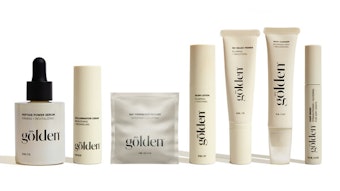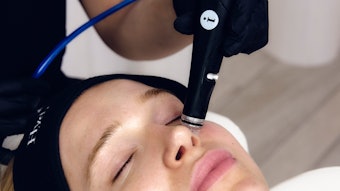
Editor's note: This article has been adapted with permission from our sister brand's, Skin Inc.'s, monthly column, "Jar Deconstructed." In it, the editors review research and commercial reports about an ingredient of interest, along with spa and professional products that apply said ingredient. It is offered solely for your consideration and further investigation. This month's piece is borrowed from the May 2020 edition of Skin Inc..
Bright and cheerful, marigolds were considered a symbol of happiness to the ancient Romans1—which is, no doubt, a boost we could all use right about now.
And, with planting season upon us and Mother’s Day around the corner, pot marigold, or Calendula officinalis (C. officinalis or calendula), seems a good choice for the May “Jar Deconstructed.” As a point of clarification, WebMD notes that calendula often is confused for the ornamental marigold of the Tagets genus, which is typically used in vegetable gardens.2 This article is focused on the C. officinalis plant.
Calendula is believed to have originated in southern Europe, in Mediterranean areas and parts of Asia, although it is now cultivated all over the world. It is an annual plant that blooms abundantly almost anywhere that it is grown. In fact, according to the Garden Guides website,1 the ancient Romans named this plant calendula because they noticed it blooming on the first day of every month (“calends”).
The plant was a symbol of joy and happiness in their gardens not only for its bright blossoms, but also because it provided a continuous supply of flowers and leaves to use in cooking and medicine. For example, calendula was common in German soups and stews, for which it earned the nickname “pot marigold.” The flowers are traditional ingredients in Mediterranean and Middle Eastern dishes as well, and the bright-colored petals were even used to add color to butter and cheese; or to dye fabrics and hair.1, 3
The Romans and Greeks, among others, also used golden calendula in rituals and ceremonies. In relation, one of calendula’s nicknames became “Mary’s Gold,” referring its use in early Catholic events in some countries.
Reported Applications
According to an article published in Pharmacognosy Review,4 C. officinalis Linn., or pot marigold, has been traditionally used to treat inflammation in internal organs, gastrointestinal ulcers and menstrual cramps, as a diuretic, and for heavy sweating during convulsions. It also addresses inflammation of the oral and pharyngeal mucosa, wounds and burns and poor eyesight.
Calendula has been reported for cleansing and detoxifying benefits, and to treat chronic infections. The dried flower tops have been utilized for antipyretic (anti-fever), anti-tumor and scarring effects. Topical infusions of the flower are also said to serve as an antifungal, antimicrobial and antiseptic for wounds, and to address marks and freckles. The essential oil of the plant also has been reported to soothe the central nervous system.4
During the Civil War and World War I, calendula flowers were reportedly used on the battlefields to treat open wounds as antihemorrhagics and antiseptics, and they were used in dressing wounds to promote healing.1, 4 The plant was also employed as a remedy for measles, smallpox and jaundice, as well as rashes, dermatitis, bee stings, foot ulcers and varicosis.4
According to the Plants For A Future nonprofit organization,5 only the common, deep-orange calendula holds medicinal value but the whole plant, especially the flowers and leaves, has anti-inflammatory, antiseptic, antispasmodic, aperient, astringent, stimulant and wound healing properties. The leaves and flowers can be used fresh or dried. A tea of the petals increases circulation and, if taken regularly, can reportedly ease varicose veins. An application of the crushed stems to corns and warts will render them easily removable, and calendula can be taken as a supplement to speed wound healing.5
Topical infusions of the flower are also said to serve as an antifungal, antimicrobial and antiseptic for wounds, and to address marks and freckles.
Active Entities
Considering the multitude of reported benefits, you might expect calendula to contain a wide variety of active constituents; and you’d be right. Work from the aforementioned Pharmacognosy Review underlined triterpene alcohols, triterpene saponins, flavonoids, carotenoids and polysaccharides as the major classes of phytoconstituents.4
More specifically, chemical analysis via high performance liquid chromatography (HPLC) revealed calendula flower extract contained ten primary actives: vitexin 11.40%, rutin 12.29%, quercetin-3-3 galactoside 12.64%, luteolin-7-glucoside 9.27%, quercetin-3-glucoside 7.38%, quercitrin 9.83%, myricetin 10%, luteolin 10.72%, apigenin 7.08% and kampferol 9.37%.6
Skin Care Benefits
Considering the phytonutrient-rich character of calendula, its traditional use in the treatment of various skin care applications for wound healing and inflammation makes good sense. In fact, its use has been reported in well over 200 cosmetic formulations including creams, lotions and even shampoos.4
Antioxidant activity. One clinical study6 confirmed the antioxidant effects of a marigold flower extract cream, which protected the skin from oxidative damage due to sunburn and reduced the signs of skin aging. According to the researchers, this effect was evident in concentrations of 10% and 15%, in comparison with a control. The researchers concluded bioactive compounds such as rutin and quercetin derivatives, vitexin, luteoline, apigenin and kampferol acted as antioxidants to restore skin health and aging resistance.6
Wound healing. A in vitro study published in the Journal of Ethnopharmacology examined three calendula extract types, n-hexanic, ethanolic and aqueous, on the inflammatory phase of wound healing in human keratinocytes and dermal fibroblasts. In particular, NF-B-DNA binding, qRT-PCR and ELISA experiments were performed.
Researchers found the n-hexanic and ethanolic extracts from calendula flowers influenced the inflammatory phase of wound healing but the migration of keratinocytes during the new tissue formation phase was only marginally influenced. However, the ethanolic extract inhibited the activity of collagenase in vitro, thus enhancing the amount of collagen in the supernatant of human dermal fibroblasts.7
While the authors noted further studies are necessary to understand what entities in calendula were responsible for these effects, they cited triterpenes as playing a marginal role, and carotene and xanthophyll derivatives warranting more attention in future studies.7
Finally, recent work published in Cellulose describes an electrospun wound dressing material including medicinal plant extracts. Botanicals utilized for their antioxidant and antibacterial properties included pot marigold, as well as yarrow, chamomile, coneflower and St. John’s wort.8
Continue reading for spa product examples the Skin Inc. May 2020 digital magazine
References
(All web sites accessed on April 3, 2020)
-
www.gardenguides.com/78027-history-calendula.html
-
www.webmd.com/vitamins/ai/ingredientmono-235/calendula
-
https://herbsocietyorg.presencehost.net/file_download/inline/4c3509e2-b57f-4383-a7e1-1ec4d0d362d5
-
www.ncbi.nlm.nih.gov/pmc/articles/PMC3841996/
-
https://pfaf.org/user/Plant.aspx?LatinName=Calendula+officinalis
-
https://iopscience.iop.org/article/10.1088/1757-899X/571/1/012082/meta
-
www.sciencedirect.com/science/article/abs/pii/S0378874116322863
-
https://link.springer.com/article/10.1007/s10570-020-03079-9










